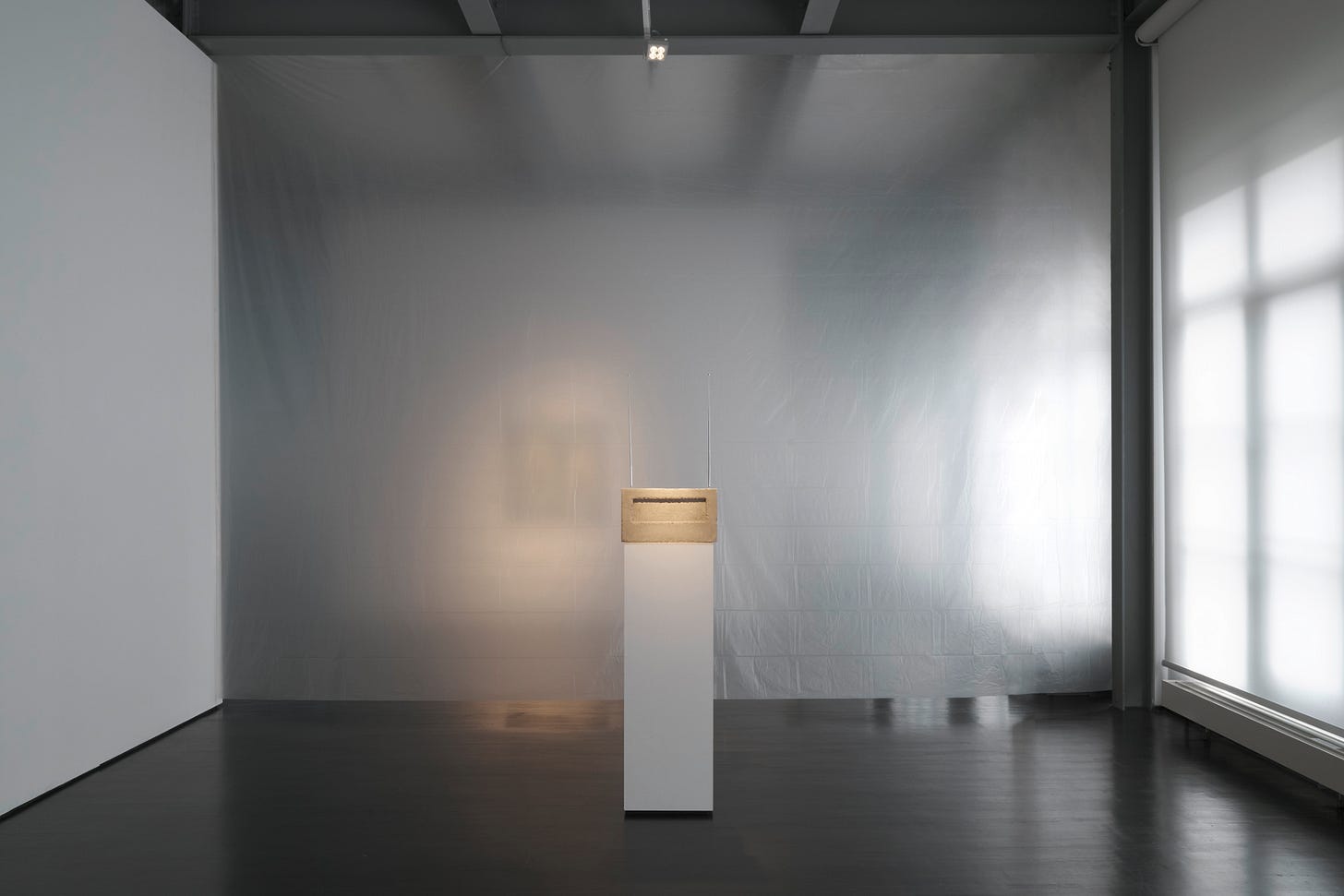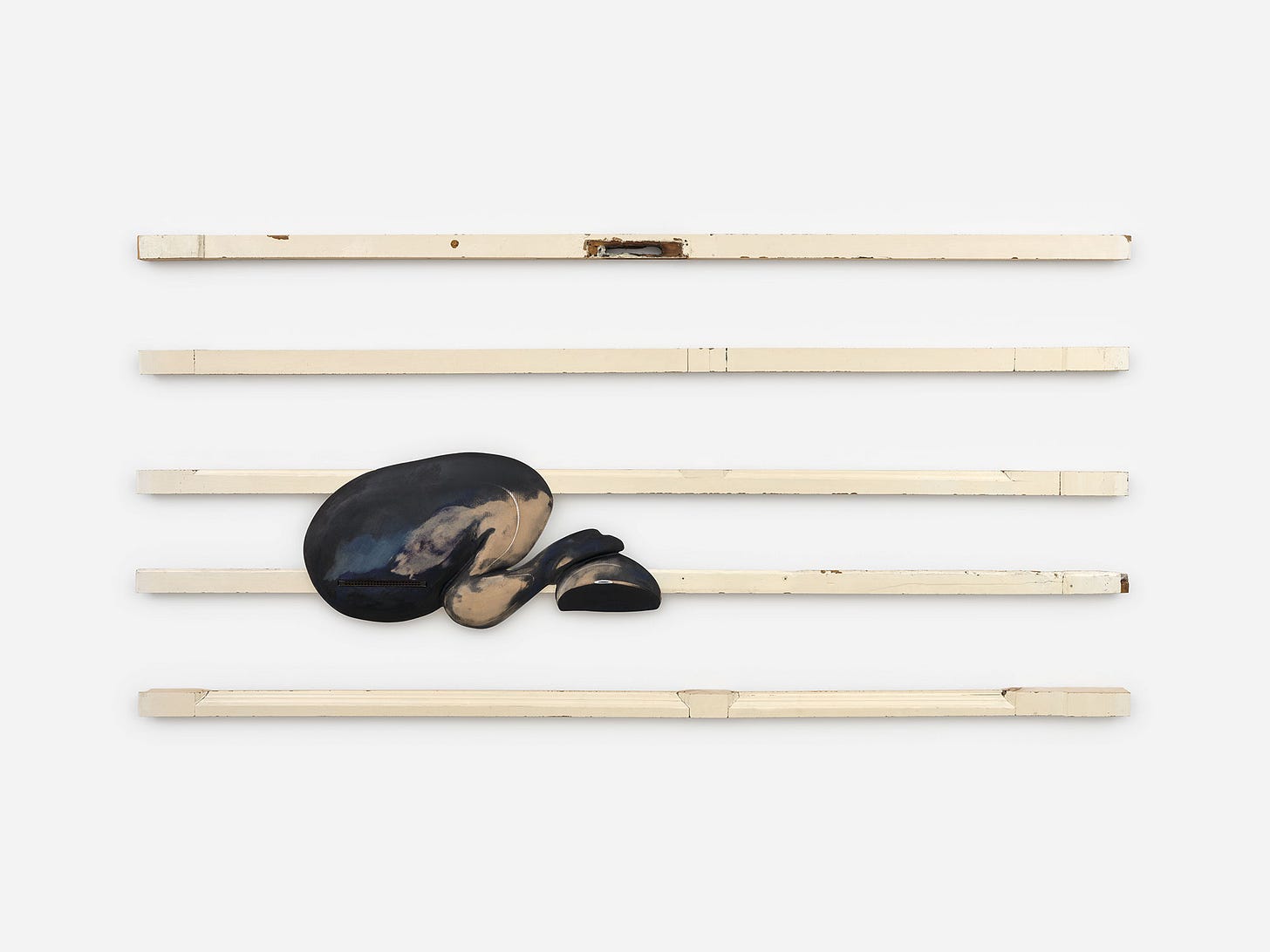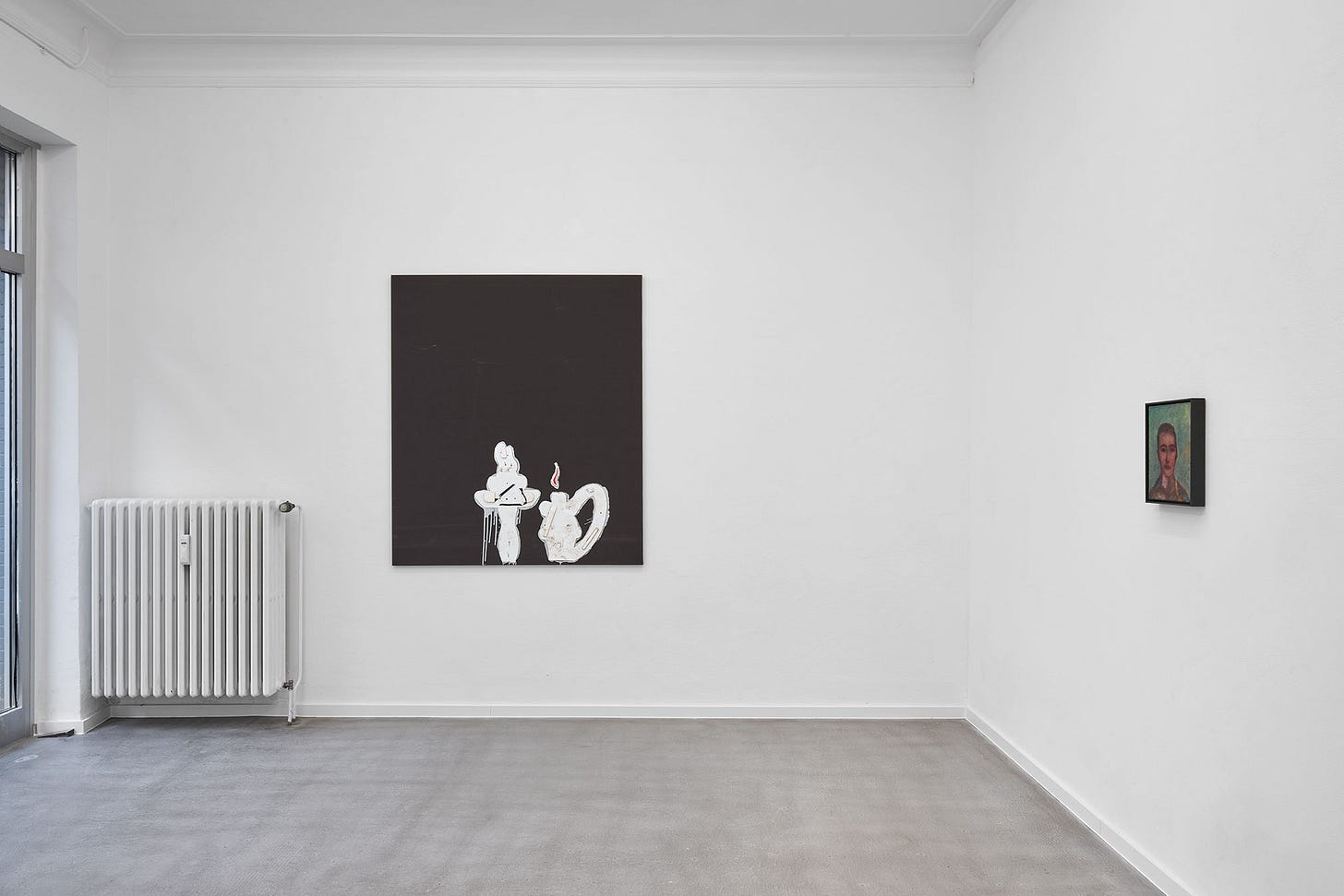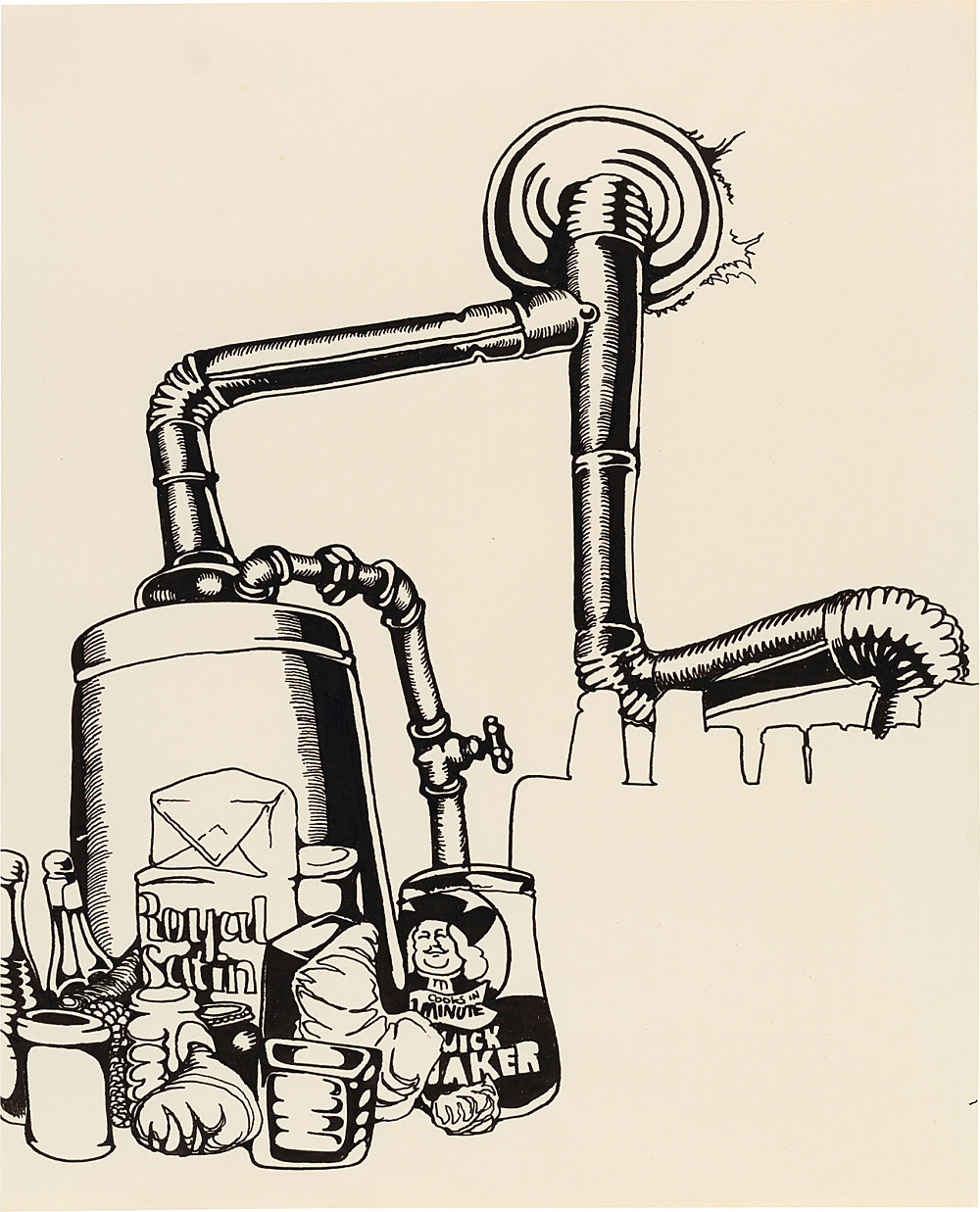3 Spring Shows in Cologne: Youth Nostalgia, Critical Caricature & A Little Hypocricy
Come along with me to Braunsfelder, Galerie Buchholz, and Khoshbakht.
The Reminiscence Bump
The broad space transformed into something temporary-looking. Matte plastic covers like those used at construction sites or during house renovations extend the white walls, blurring the incoming light into milky diffusion. Curated by the gallery Super Super Markt, the show is based on an essay. I read in the press release: “The title of that text, now the title of this exhibition, refers to the well-documented tendency for adults to preserve a disproportionate number of memories originating in adolescence and early adulthood.”

Five artists participate in this show. Douglas Gordon (Baby Boomer, Scottish) slowed down found footage of a concert with Bootleg (Bigmouth) (1996) and put it on mute. My experience of the concert is limited to the visual agitation of the performer. The distorted format brings forth new glitchy colors, ultimately altering someone’s foreign memory of that moment.
Talisa Lallai’s (Millennial, German) Sketch of Summer (2025) was an arrangement of seemingly random shots in a tight horizontal slit. It reminded me of Mike Kelley’s (1954-2012, US-American) Black Out (Detroit River) (2001) consisting of poorly developed shots taken on the road, metaphorically recalling childhood road trips and fluttering attention. Otherwise, her floral and coastal photographs were pretty, but not that memorable in my humble opinion. Neither did I get how Omari Douglin’s (Millennial, USA) paramilitary Brown Nudes (2025) fit into the show.
Two Weltempfänger (2015 and 2016) by Isa Genzken (Baby Boomer, German) are concrete slobs with two antennas sticking out. I know, I know, “dO gEn z EVen KnOw whAT A rAdIO IS?” — “Yes”. But they don’t look so much like nostalgic remains of a time when the quantity of communication channels was more manageable. There’s something uncanny about radios. No, really. When you watch a scary movie and people drive through a dark forest, losing the radio signal is pretty much the first sign things are about to get bad. Or when there’s some mysterious substance in the air and the radio frantically switches channels back and forth — bad vibes.

Gowoon Lee (Millennial, South Korean) has a new fan for sure. She paints details from childhood cartoons. But instead of imitating a slick TV screen, she goes for a textured surface like jute. It seems as if she’s not interested in imitating the moment of watching the cartoon but the memory attached to it. I get to feel the memory through the imagined touch. Gowoon froze Popeye throwing hands, the very moment he tripples through the rapid movement. Almost like Italian Futurism if it weren’t for the soft dissolution of his body. And without the fascism, of course. From Tom and Jerry, Gowoon took the iconic purple sofa and tiled kitchen background. Watching Tom and Jerry back in the day, I hated how the animation details could spoil the plot: Like, you’d have a perfectly even picket fence but that one post was more pronounced and detailed, so you’d know that the character was going to crash into that specific spot in a second. There’s actually a wholesome TikTok trend celebrating the beauty of old-school cartoon backgrounds. Entire slideshows are dedicated to those visuals, most often accompanied by Glenn Miller’s Moonlight Serenade (1939).

Braunsfelder, until May 11, 2025. Geisselstrasse 84 - 86, 50823 Cologne
Martin Wong: Works on Paper
When thinking of Martin Wong (1946-99, US-American), I recall his paintings blending both Chinese and US-American styles. I have never seen any of his work in the flesh so far. Here, I get to start with his works on paper.
The gallery brought together works from 1968 to 1997 and they instantly caught me. Resumé Consumé de Martin Wong (c. 1975) is his CV written with ink on paper and damn, Martin really got around a lot. The writing style seems to mimic Chinese script and there’s two red stamps in the left upper corner. With the headline in French, that really looks like a proper hard-working Asian-American model minority resume.
Martin kept it caricaturesque. Two swirling ice cream cones connect at their tops like yin and yan. But the waffle looks studded rather than baked. And the EAT IT ALL phrase on them is the consumerist opposite of balanced calm. When drawing groceries, Martin makes the packaging look uncannily gooey. Instant dry milk… in a box? In one untitled work from 1970, the groceries are arranged in front of a boiler and pipes extend into nothingness. I don’t know where it’s coming from but best believe ain’t shit organic about this stuff. It’s giving that one scene from the French comedy Joe: The Busy Body or The Gazebo (1971) where they find out how fast food is made. The dude from the Quick Quaker Oats packaging looks like an unsympathetic smirking Dollar-Bill guy rather than the pious friendly “we have no issue with Natives as long as they don’t get on our land” fella. Oh wait, that’s the same guy.
Yeah, Martin played around, but it’s not just all giggles and shit. In fact, there’s more art historical references. Looking at Hard At Work - Brian (1973) with his sharp handwriting and the sculpted portrait with crazy eyes, there’s no way Martin wasn’t a peak-Symbolism Franz von Stuck (1863-1928, German) fan. And Gail Gousha (1969) dissolving with her hair and dress into the upholstered sofa could easily be a sea nymph by Edvard Munch (1863 - 1944, Norwegian).
Galerie Buchholz, until May 3, 2025. Neven-DuMont-Str. 17, 50667 Cologne
Portrait: Beth Collar, Behrang Karimi, Mitchell Kehe, René Kemp, Yoora Park, Raha Raissnia
God forbid a girl catches a vibe and contradicts herself — I recently said in an interview (yes, I’m using this as an opportunity to flex that I got interviewed) that I don’t see the point in reviewing gallery roster presentations that are not exactly thematic group shows. But I saw the latest Khoshbakht show and think it’s worth having a look.
Although Beth Collar (Millennial, British) titled her work Thinking Here Of How The Words Formulate Inside My Head As I Am Just Thinking (2016-2018), I don’t see a single thought behind those wooden eyes. Beth sculpted a meticulously shaped female-presenting head with the limewood seamlessly suggesting a light beige skin tone. The surface looks velvety smooth, a splinter here or there disguised as a minor blemish. Only for the hairline, she broke the illusion by exposing the unrefined structure. I realize why the eyes look so dead to me: It’s the fact that Beth added the slightest shade of color. If it were a pure wooden piece, I would have read the expression as surprise or suspense. But the matte blue eyes look as if they’re still buried under wooden layers that still need to be exposed.

Mitchell Kehe’s (Millennial, US-American) Untitled 4 (the wheel turns) (2023) feels uncannily urgent. I was sure that I’m looking at pieces arranged on canvas, but it was synthetic fabric as usual for him. The fabric turns into vast darkness interrupted only by two white shapes at the bottom. The one on the right looks like an oil lamp while the one on the left resembles the torch held by the Statue of Liberty. This one isn’t bronze, though, but enamel, masking tape, and found objects. That Liberty is trashy. There’s no light coming from the sources except for a weak red flame glued over the lamp. If at all, the light surrenders to the darkness, dripping down the white silhouettes. Put this next to a Jasper Johns (Silent Generation, US-American) flag right now.
I definitely caught feelings for Yoora Park’s (Millennial, South-Korean) Red Honey (2025), five horizontal wood pieces with an MDF horse leg attached to one. Did the little horse try to escape the fenced stable and accidentally get its leg stuck? As I was talking with gallerist Manoucher, he drew my attention to the harmonica inserted in the thigh, mentioning that Yoora frequently works with music. And suddenly, the whole piece looked like music to me: The five horizontal wood pieces equal the lines on a music sheet. And maybe the shape attached used to be a little note in a melody the composer wrote as Prestissimo (for non-musicians: that means “fast as fuc boi”), accelerating the sound to the point it morphed into a horse and galloped away.

Khoshbakht, until April 12, 2025. Jülicher Straße 24a, 50674 Cologne
Next week, I’m sharing my Critic’s Pick for this year’s edition of Art Düsseldorf! Stay tuned!
Thank you for following this art route! If you enjoyed it, please consider leaving a like or even commenting your thoughts. It’s much appreciated!
See you soon!!!
Jennifer
The Gen Z Art Critic






